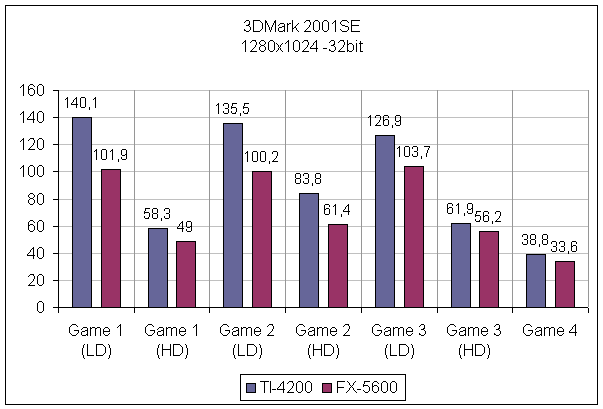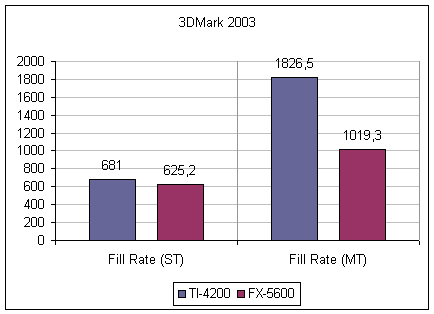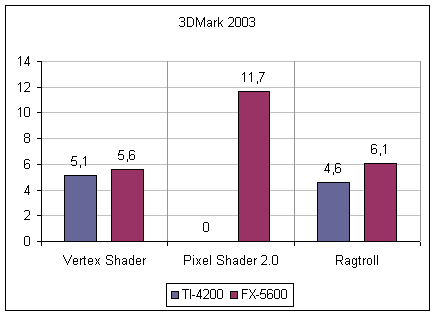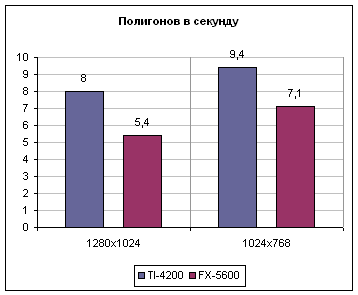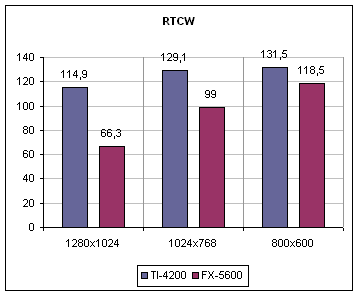nVidia GeForce FX5600 (NV31) Video Card Roundup
Benchmarks
Dealing with a new product, you can't help comparing it with the predecessor. So we'll do that and call up the honored veteran to the "boxing rings". Yes, that's just it! As a contender to the card being tested we took the Albatron Geforce 4 TI 4200 (128MB onboard) that had undergone some damage after those risky experiments but equipped with a new fan. Since the 5600 and 4200 models fall within the mainstream sector, a comparison like this appears to me quite adequate, because in the glorious times of GeForce 4 a card of this series cost about $200. Currently, the MS-8912 takes a similar price niche. The main question on the testing agenda - isn't it higher time to do an upgrade?
Here are the main specifications of the Geforce 4 Ti 4200:
| The chip: |
GeForce FX5600 |
GeForce 4 Ti4200 |
| RAM capacity |
256 Mb |
128 Mb |
| The graphics core clock speeds: |
325 MHz |
250MHz |
| Memory clock speeds: |
550MHz |
500MHz |
| Memory bandwidth: |
11.2 GB/s |
8 GB/s |
| Output speeds: |
1.4 trln texels/s. |
4 trln texels/s. |
| Vertices per second: |
88 mln |
113 mln |
For performance comparisons, we used the following:
- MadOnion 3DMark 2001SE – a Direct 3D (DirectX 8.1) benchmark
- MadOnion FutureMark 2003 – a Direct 3D (DirectX 9) benchmark
- CodeCreatures – an extremely overkill benchmark to measure performance in Direct 3D (DirectX 8.1)
- Return to castle Wolfenstein – an OpenGL gaming benchmark
Test configuration:
| CPU |
AMD AthlonXP 2500+ (Barton) |
| Motherboard |
Epox 8RDA (NForce2) |
| Memory RAM |
512 Mb DDR400 (Dual Channel) |
| HDD |
HDD 80Gb IBM IC35L |
| LCD |
Bliss 1700RT (max. 1280х1024) |
| Software: |
Windows XP Professional + ServicePack 1
Detonator 44.03 |
MadOnion 3DMark 2001SE
With the AA disabled, we produced the following results:
Enabling the AA gives somewhat different results:
As you see, the Ti 4200 evidently lags behind in the former case and gets a very small lead in the latter. What does it show? The card seems to have a good potential, but the existing software does not allow the card to reveal itself to the full. Put into a plain language, this means the 5600 will be of no use to those who are indifferent to anti-aliasing and other "tricks".
MadOnion Future Mark 2003
That's just where MS-8912 shows its talents to the full. Along with the support for Pixel Shaders 2.0, the card does quite a good job coping with the remaining DirectX 9 benchmarks, although the results produced are very far from being called "fantastic". The conclusion is pretty interesting, but let's put it aside until the end. Now get on to other benchmarks.
CodeCreatures
It's absolutely evident that in the DirectX 8.1 benchmark the performance crown is indisputably with Ti4200.
Return to Castle Wolfenstein
The Ti4200 takes almost as twice a lead over the contender in high resolutions, but at 800x600 the gap is almost void. However, don't forget that as prices for high-resolution monitors go down, the number of low-resolution fanciers is swiftly going down.
Results
The conclusion goes without saying: the MS-8912 is aimed at future potentials of 3D graphics, but in the current applications it is still unable to beat even the Ti4200.
What's more, as the Future Mark 2003 benchmarks show, the FX5600 is not doing very well at DirectX 9 benchmarks either, which is hardly to bring a positive effect on its application in future-generation games. In my view, 11 fps, let alone 6 fps, is too slow for a comfortable gameplay in a dynamic first-person shooter. By the way, specialists at nVidia keep to the same view. At the conference mentioned in the beginning of this roundup, as a reply to one of the journalists' question, Alan Tike pronounced the figure as high as 26 fps. To cut it short, the card proved to be a bit weird, but that we'll tell in the final words which we'll bring in after covering a very important circumstance.
So.. Some readers might ask why the description of image quality with screenshots is missing. As for the 2D graphics, at that there's nothing to complain about in this card of MSI. The same applies to the TV-out. Things with the 3D graphics appear to be somehow difficult, since screenshots are unlikely to serve as the evidence. Evidently, there is a dependence of image quality on the operation of programs that generate it as well as the driver settings in the video card itself. Moreover, the subjective perception of displayed textures prevents a one-one estimation of the video card performance. Of course, there is such thing like realism, but that doesn't relate to a static 3D image but to a moving object due to the lightmaps and dynamics of 3D models. That is vividly seen from the demo reels in the well-known Dawn. Hopefully, in the near future there will be found a way to translate high-quality video for plain objects to demonstrate the card's potentials in action. For now, let's sum it all up.
Overall conclusion
As the conducted benchmarks showed, the FX5600 chip albeit positioned as a replacement to the GeForce 4 Ti4200 chip can hardly match it. The problem is not only in the lack of software able implementing the DX9 potentials to the full, but also in its slow speed. Besides, having rounded up video cards based on the GeForce FX, you arrive at an unpleasant finding - currently, nVidia offers no good video cards for the mainstream sector. Due to the lack of games demanding GeForce FX to function properly, we believe it is not reasonable to be hasty at upgrading GeForce 4Ti models.
Read more on this topic: GeForce FX5200 (NV34) GeForce FX5200 (NV34)
 3DMark 2003: see the future 3DMark 2003: see the future
 |
Content: |
 |
|
 |
Top Stories: |
 |
 |
 |
MoBo:


|
 |
 |
 |
VGA Card:


|
 |
 |
 |
CPU & Memory:

|
|
|





